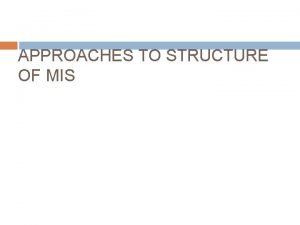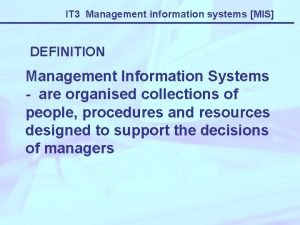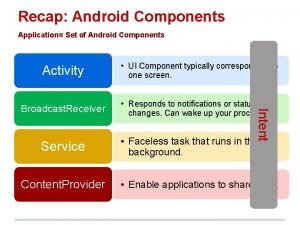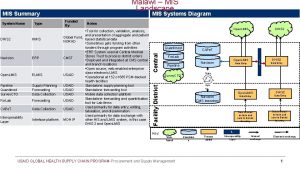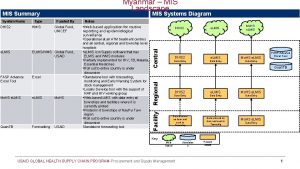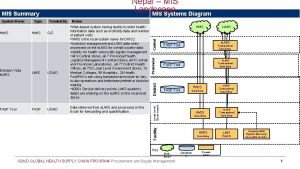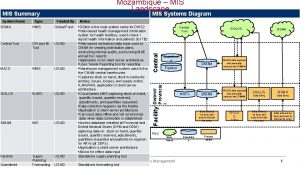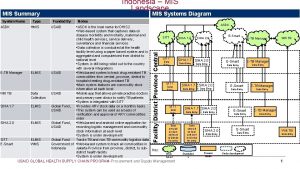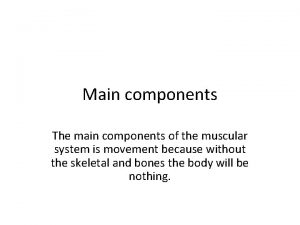APPROACHES TO STRUCTURE OF MIS COMPONENTS Main components















- Slides: 15

APPROACHES TO STRUCTURE OF MIS

COMPONENTS Main components of this approach are as follows: Operational elements MIS subsystems MIS and decision support Information system processing functions MIS structure based on management activity

OPERATIONAL ELEMENTS ELEMENT DECRIPTION hardware Multiple computer system: Mainframes, minicomputers, personal computers Computer system components are: central processor, memory hierarchy input and output devices Communications: local area networks, metropolitan area network, and wide area networks software System software and application software database Organized collections of data used by application software personnel Professional cadre of computer specialists: end users in certain aspects of their work procedures Specifications for the use and operation of compurtized information systems collected in user mannuals.

MIS SUBSYSTEMS Functional subsystems Some typical reports Marketing analysis and sales forecasting report sale planning report, customer and sales analysis report Production planning reports, quality control reports Personnel personnel information reports, training and leave records Finance and accounting General accounting reports, payroll accounting reports, bonus and IT reports , cost analysis reports.

MIS AND DECISION MAKINNG Structured, programmable decisions: -when a decision can be programmed, an organization can prepare decision rule or procedure. This can be expressed as a steps to follow, a flowchart, a decision table or a formula. Unstructured, non programmable decisions: In unstructured decision has no pre established decision procedure because the decision process is not understood well or it is too unchangeable.

INFORMATION SYSTEM PROCESSING FUNCTIONS To process transactions: FILES TRANSAC TION PROCESS TRANSACTIONS TRANSACTI ON DOCUMENT

To update a master file: TRAN SACTI ON DATA MAST ER FILE CHAR GES MAST ER FILES UPDATE MASTER FILES UPDAT ED MASTE R FILES

To produce reports: - FILES PREPARE REPORTS REPORT

To process enquiries: - HANDLE ENQIRY INQUIRY FILES INQUIRY RESPONSE

To process interactive support application: - DECISION MAKER MODEL INPUT AND OUTPUT DECISION MODEL PROCESSING

MIS STRUCTURE BASED ON MANAGEMENT ACTIVITY Provide information to different levels of management for discharging their function more effectively. • Strategic management • Management control • Operational management

Information system for operational management The responsibility of operational level management is to supervise operational activities. Operational control makes use of pre established procedure and decision rules. They supervise the day to day activities. Information of this level mainly comes from internal data generated from tranctions.

Tactical management Management control information is required by managers of departments, profit centers etc to measure performance, decide control actions, formulate new decision rules to be applied by operational personnel.

Strategic management The purpose of strategic planning is to formulate strategies to achieve organization goals. They make long term plans. They depend upon external data such as competitors policy, market condition, government policies etc. or decision making. Hence decisions at this level are unstructured and non programmed.

Thank You
 Mis subsystems
Mis subsystems Approaches of corporate governance
Approaches of corporate governance Fundamental forecasting of exchange rates
Fundamental forecasting of exchange rates Principios de un proyecto de vida
Principios de un proyecto de vida Mama hijo y sobrino
Mama hijo y sobrino Mis mai a mis tachwedd
Mis mai a mis tachwedd Mis mai a mis tachwedd
Mis mai a mis tachwedd Cuales son mis creencias
Cuales son mis creencias Mis meaning
Mis meaning Form of will future
Form of will future A.1 determine the main idea of a passage
A.1 determine the main idea of a passage Void main int main
Void main int main Struktur informasi manajemen
Struktur informasi manajemen Function of saliva
Function of saliva Application
Application What is anthropological perspective
What is anthropological perspective
